Corporations Law Essay: Evaluating Incorporation's Significance
VerifiedAdded on 2023/01/17
|8
|2680
|71
Essay
AI Summary
This essay critically examines the statement that "The case for incorporation is overstated." It begins by outlining the benefits of corporate structures, such as separate legal identity and limited liability, supported by case law like Salomon v A Salomon & Co Ltd and Lee v Lee’s Air Farming Ltd. It then acknowledges the disadvantages, including high set-up and operational costs, and the potential for misuse of corporate personality and limited liability. The essay explores the legal safeguards in place, such as directors' duties under the Corporations Act 2001 (Cth) and the concept of lifting the corporate veil, referencing cases like ASIC v Sino Australia Oil and Gas Limited and Gilford Motor Co Ltd v Horne. It concludes that while the costs and complexities of incorporation exist, the benefits and legal protections render the statement inaccurate.

CORPORATION LAW
Paraphrase This Document
Need a fresh take? Get an instant paraphrase of this document with our AI Paraphraser
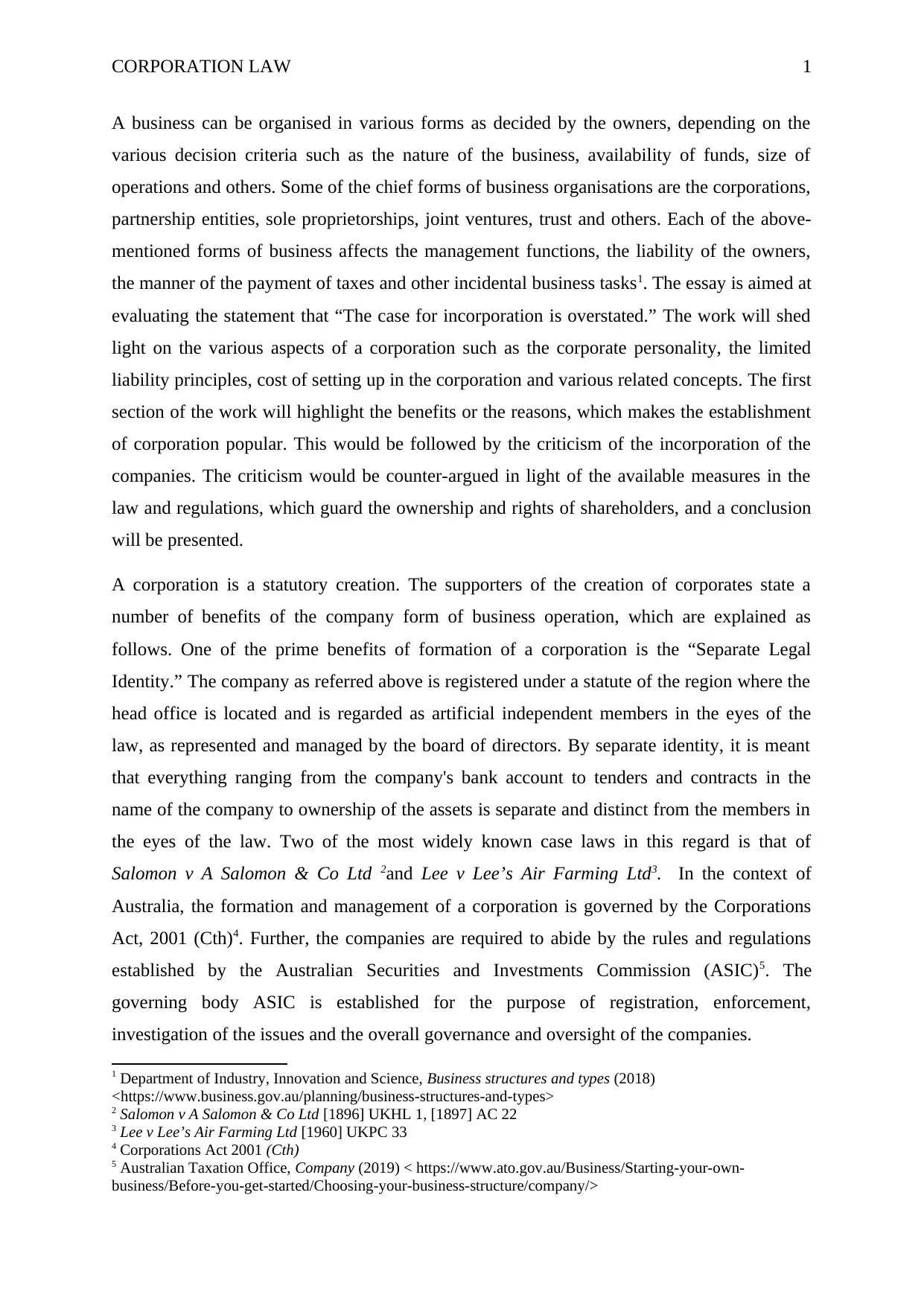
CORPORATION LAW 1
A business can be organised in various forms as decided by the owners, depending on the
various decision criteria such as the nature of the business, availability of funds, size of
operations and others. Some of the chief forms of business organisations are the corporations,
partnership entities, sole proprietorships, joint ventures, trust and others. Each of the above-
mentioned forms of business affects the management functions, the liability of the owners,
the manner of the payment of taxes and other incidental business tasks1. The essay is aimed at
evaluating the statement that “The case for incorporation is overstated.” The work will shed
light on the various aspects of a corporation such as the corporate personality, the limited
liability principles, cost of setting up in the corporation and various related concepts. The first
section of the work will highlight the benefits or the reasons, which makes the establishment
of corporation popular. This would be followed by the criticism of the incorporation of the
companies. The criticism would be counter-argued in light of the available measures in the
law and regulations, which guard the ownership and rights of shareholders, and a conclusion
will be presented.
A corporation is a statutory creation. The supporters of the creation of corporates state a
number of benefits of the company form of business operation, which are explained as
follows. One of the prime benefits of formation of a corporation is the “Separate Legal
Identity.” The company as referred above is registered under a statute of the region where the
head office is located and is regarded as artificial independent members in the eyes of the
law, as represented and managed by the board of directors. By separate identity, it is meant
that everything ranging from the company's bank account to tenders and contracts in the
name of the company to ownership of the assets is separate and distinct from the members in
the eyes of the law. Two of the most widely known case laws in this regard is that of
Salomon v A Salomon & Co Ltd 2and Lee v Lee’s Air Farming Ltd3. In the context of
Australia, the formation and management of a corporation is governed by the Corporations
Act, 2001 (Cth)4. Further, the companies are required to abide by the rules and regulations
established by the Australian Securities and Investments Commission (ASIC)5. The
governing body ASIC is established for the purpose of registration, enforcement,
investigation of the issues and the overall governance and oversight of the companies.
1 Department of Industry, Innovation and Science, Business structures and types (2018)
<https://www.business.gov.au/planning/business-structures-and-types>
2 Salomon v A Salomon & Co Ltd [1896] UKHL 1, [1897] AC 22
3 Lee v Lee’s Air Farming Ltd [1960] UKPC 33
4 Corporations Act 2001 (Cth)
5 Australian Taxation Office, Company (2019) < https://www.ato.gov.au/Business/Starting-your-own-
business/Before-you-get-started/Choosing-your-business-structure/company/>
A business can be organised in various forms as decided by the owners, depending on the
various decision criteria such as the nature of the business, availability of funds, size of
operations and others. Some of the chief forms of business organisations are the corporations,
partnership entities, sole proprietorships, joint ventures, trust and others. Each of the above-
mentioned forms of business affects the management functions, the liability of the owners,
the manner of the payment of taxes and other incidental business tasks1. The essay is aimed at
evaluating the statement that “The case for incorporation is overstated.” The work will shed
light on the various aspects of a corporation such as the corporate personality, the limited
liability principles, cost of setting up in the corporation and various related concepts. The first
section of the work will highlight the benefits or the reasons, which makes the establishment
of corporation popular. This would be followed by the criticism of the incorporation of the
companies. The criticism would be counter-argued in light of the available measures in the
law and regulations, which guard the ownership and rights of shareholders, and a conclusion
will be presented.
A corporation is a statutory creation. The supporters of the creation of corporates state a
number of benefits of the company form of business operation, which are explained as
follows. One of the prime benefits of formation of a corporation is the “Separate Legal
Identity.” The company as referred above is registered under a statute of the region where the
head office is located and is regarded as artificial independent members in the eyes of the
law, as represented and managed by the board of directors. By separate identity, it is meant
that everything ranging from the company's bank account to tenders and contracts in the
name of the company to ownership of the assets is separate and distinct from the members in
the eyes of the law. Two of the most widely known case laws in this regard is that of
Salomon v A Salomon & Co Ltd 2and Lee v Lee’s Air Farming Ltd3. In the context of
Australia, the formation and management of a corporation is governed by the Corporations
Act, 2001 (Cth)4. Further, the companies are required to abide by the rules and regulations
established by the Australian Securities and Investments Commission (ASIC)5. The
governing body ASIC is established for the purpose of registration, enforcement,
investigation of the issues and the overall governance and oversight of the companies.
1 Department of Industry, Innovation and Science, Business structures and types (2018)
<https://www.business.gov.au/planning/business-structures-and-types>
2 Salomon v A Salomon & Co Ltd [1896] UKHL 1, [1897] AC 22
3 Lee v Lee’s Air Farming Ltd [1960] UKPC 33
4 Corporations Act 2001 (Cth)
5 Australian Taxation Office, Company (2019) < https://www.ato.gov.au/Business/Starting-your-own-
business/Before-you-get-started/Choosing-your-business-structure/company/>
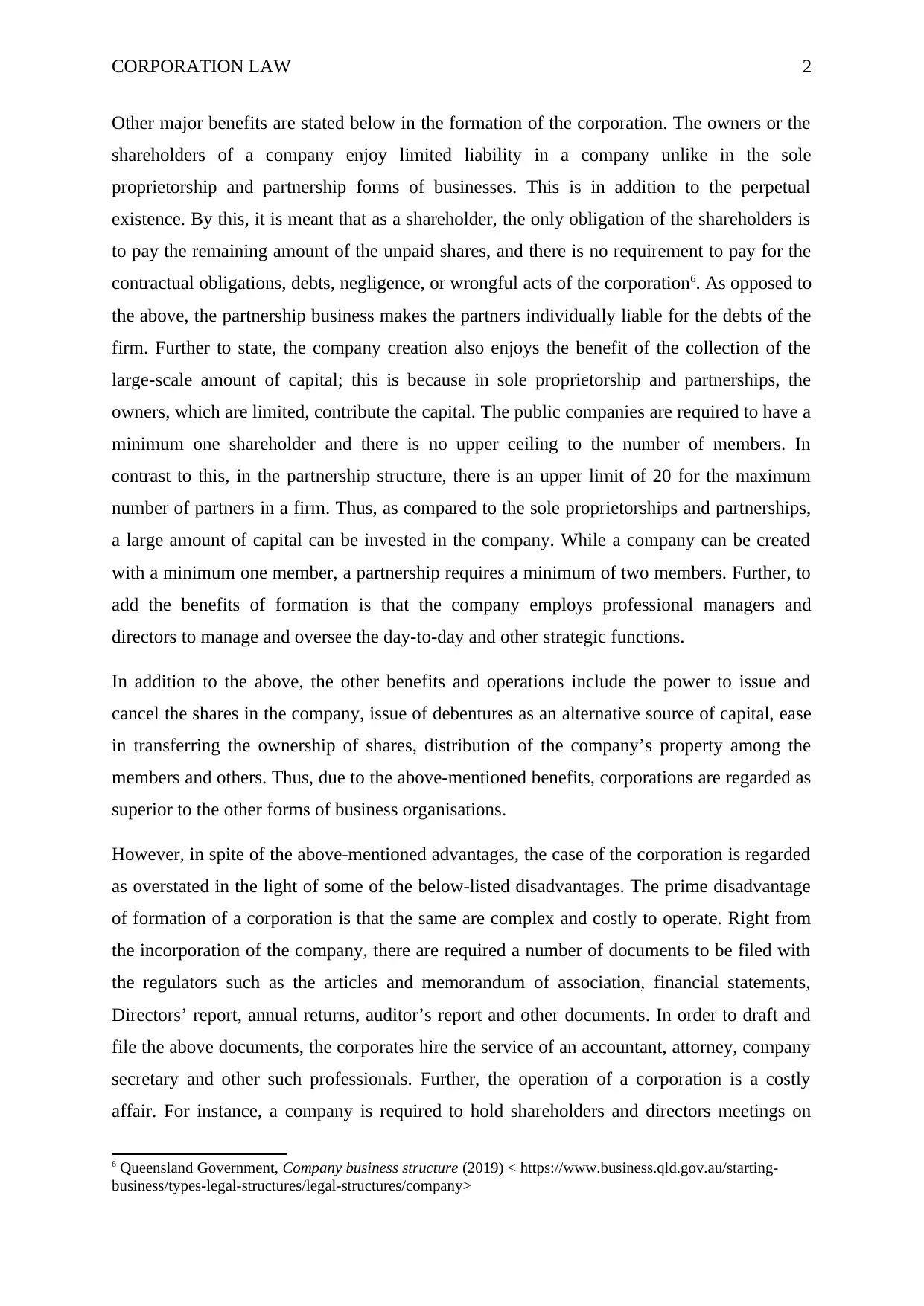
CORPORATION LAW 2
Other major benefits are stated below in the formation of the corporation. The owners or the
shareholders of a company enjoy limited liability in a company unlike in the sole
proprietorship and partnership forms of businesses. This is in addition to the perpetual
existence. By this, it is meant that as a shareholder, the only obligation of the shareholders is
to pay the remaining amount of the unpaid shares, and there is no requirement to pay for the
contractual obligations, debts, negligence, or wrongful acts of the corporation6. As opposed to
the above, the partnership business makes the partners individually liable for the debts of the
firm. Further to state, the company creation also enjoys the benefit of the collection of the
large-scale amount of capital; this is because in sole proprietorship and partnerships, the
owners, which are limited, contribute the capital. The public companies are required to have a
minimum one shareholder and there is no upper ceiling to the number of members. In
contrast to this, in the partnership structure, there is an upper limit of 20 for the maximum
number of partners in a firm. Thus, as compared to the sole proprietorships and partnerships,
a large amount of capital can be invested in the company. While a company can be created
with a minimum one member, a partnership requires a minimum of two members. Further, to
add the benefits of formation is that the company employs professional managers and
directors to manage and oversee the day-to-day and other strategic functions.
In addition to the above, the other benefits and operations include the power to issue and
cancel the shares in the company, issue of debentures as an alternative source of capital, ease
in transferring the ownership of shares, distribution of the company’s property among the
members and others. Thus, due to the above-mentioned benefits, corporations are regarded as
superior to the other forms of business organisations.
However, in spite of the above-mentioned advantages, the case of the corporation is regarded
as overstated in the light of some of the below-listed disadvantages. The prime disadvantage
of formation of a corporation is that the same are complex and costly to operate. Right from
the incorporation of the company, there are required a number of documents to be filed with
the regulators such as the articles and memorandum of association, financial statements,
Directors’ report, annual returns, auditor’s report and other documents. In order to draft and
file the above documents, the corporates hire the service of an accountant, attorney, company
secretary and other such professionals. Further, the operation of a corporation is a costly
affair. For instance, a company is required to hold shareholders and directors meetings on
6 Queensland Government, Company business structure (2019) < https://www.business.qld.gov.au/starting-
business/types-legal-structures/legal-structures/company>
Other major benefits are stated below in the formation of the corporation. The owners or the
shareholders of a company enjoy limited liability in a company unlike in the sole
proprietorship and partnership forms of businesses. This is in addition to the perpetual
existence. By this, it is meant that as a shareholder, the only obligation of the shareholders is
to pay the remaining amount of the unpaid shares, and there is no requirement to pay for the
contractual obligations, debts, negligence, or wrongful acts of the corporation6. As opposed to
the above, the partnership business makes the partners individually liable for the debts of the
firm. Further to state, the company creation also enjoys the benefit of the collection of the
large-scale amount of capital; this is because in sole proprietorship and partnerships, the
owners, which are limited, contribute the capital. The public companies are required to have a
minimum one shareholder and there is no upper ceiling to the number of members. In
contrast to this, in the partnership structure, there is an upper limit of 20 for the maximum
number of partners in a firm. Thus, as compared to the sole proprietorships and partnerships,
a large amount of capital can be invested in the company. While a company can be created
with a minimum one member, a partnership requires a minimum of two members. Further, to
add the benefits of formation is that the company employs professional managers and
directors to manage and oversee the day-to-day and other strategic functions.
In addition to the above, the other benefits and operations include the power to issue and
cancel the shares in the company, issue of debentures as an alternative source of capital, ease
in transferring the ownership of shares, distribution of the company’s property among the
members and others. Thus, due to the above-mentioned benefits, corporations are regarded as
superior to the other forms of business organisations.
However, in spite of the above-mentioned advantages, the case of the corporation is regarded
as overstated in the light of some of the below-listed disadvantages. The prime disadvantage
of formation of a corporation is that the same are complex and costly to operate. Right from
the incorporation of the company, there are required a number of documents to be filed with
the regulators such as the articles and memorandum of association, financial statements,
Directors’ report, annual returns, auditor’s report and other documents. In order to draft and
file the above documents, the corporates hire the service of an accountant, attorney, company
secretary and other such professionals. Further, the operation of a corporation is a costly
affair. For instance, a company is required to hold shareholders and directors meetings on
6 Queensland Government, Company business structure (2019) < https://www.business.qld.gov.au/starting-
business/types-legal-structures/legal-structures/company>
⊘ This is a preview!⊘
Do you want full access?
Subscribe today to unlock all pages.

Trusted by 1+ million students worldwide
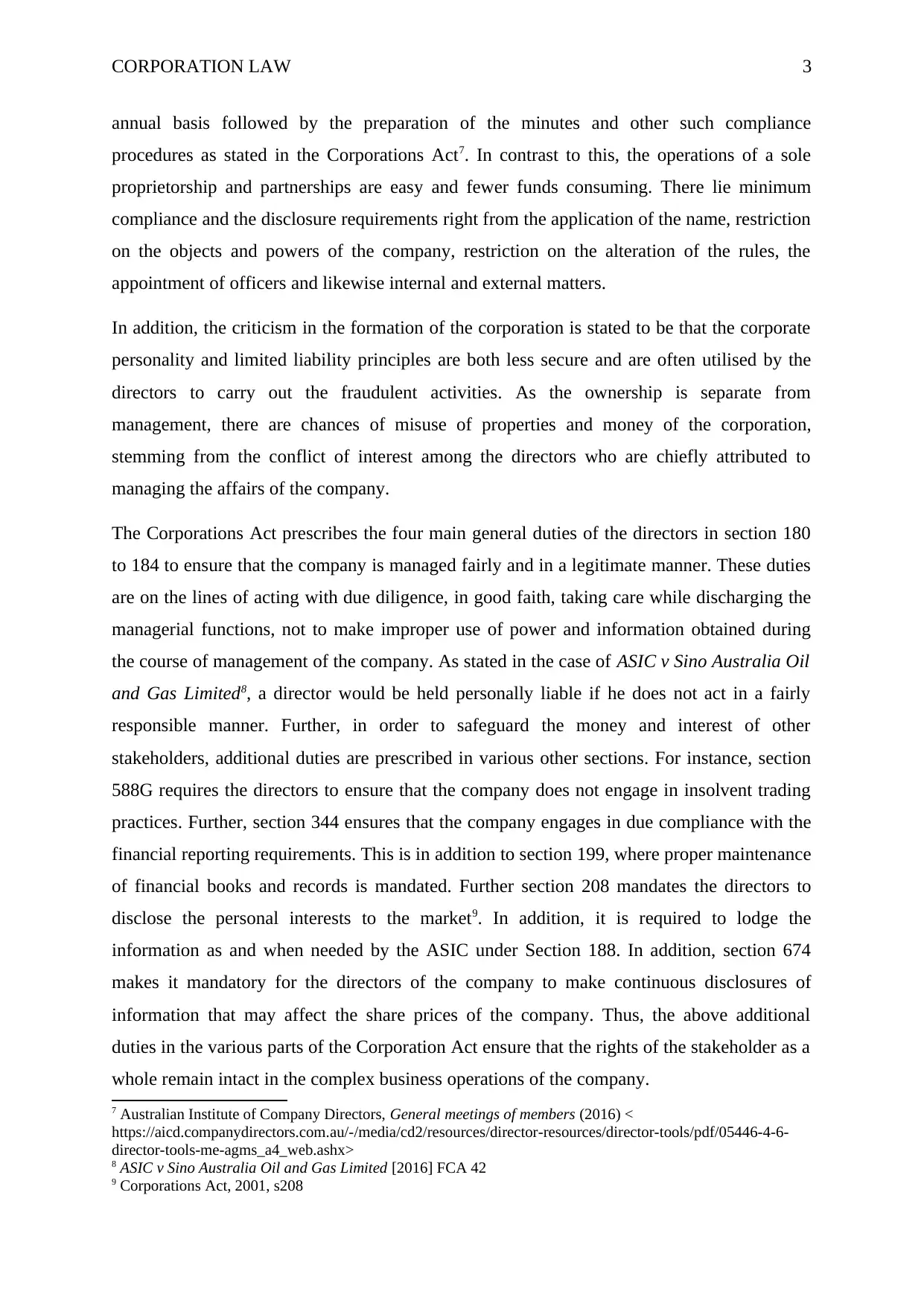
CORPORATION LAW 3
annual basis followed by the preparation of the minutes and other such compliance
procedures as stated in the Corporations Act7. In contrast to this, the operations of a sole
proprietorship and partnerships are easy and fewer funds consuming. There lie minimum
compliance and the disclosure requirements right from the application of the name, restriction
on the objects and powers of the company, restriction on the alteration of the rules, the
appointment of officers and likewise internal and external matters.
In addition, the criticism in the formation of the corporation is stated to be that the corporate
personality and limited liability principles are both less secure and are often utilised by the
directors to carry out the fraudulent activities. As the ownership is separate from
management, there are chances of misuse of properties and money of the corporation,
stemming from the conflict of interest among the directors who are chiefly attributed to
managing the affairs of the company.
The Corporations Act prescribes the four main general duties of the directors in section 180
to 184 to ensure that the company is managed fairly and in a legitimate manner. These duties
are on the lines of acting with due diligence, in good faith, taking care while discharging the
managerial functions, not to make improper use of power and information obtained during
the course of management of the company. As stated in the case of ASIC v Sino Australia Oil
and Gas Limited8, a director would be held personally liable if he does not act in a fairly
responsible manner. Further, in order to safeguard the money and interest of other
stakeholders, additional duties are prescribed in various other sections. For instance, section
588G requires the directors to ensure that the company does not engage in insolvent trading
practices. Further, section 344 ensures that the company engages in due compliance with the
financial reporting requirements. This is in addition to section 199, where proper maintenance
of financial books and records is mandated. Further section 208 mandates the directors to
disclose the personal interests to the market9. In addition, it is required to lodge the
information as and when needed by the ASIC under Section 188. In addition, section 674
makes it mandatory for the directors of the company to make continuous disclosures of
information that may affect the share prices of the company. Thus, the above additional
duties in the various parts of the Corporation Act ensure that the rights of the stakeholder as a
whole remain intact in the complex business operations of the company.
7 Australian Institute of Company Directors, General meetings of members (2016) <
https://aicd.companydirectors.com.au/-/media/cd2/resources/director-resources/director-tools/pdf/05446-4-6-
director-tools-me-agms_a4_web.ashx>
8 ASIC v Sino Australia Oil and Gas Limited [2016] FCA 42
9 Corporations Act, 2001, s208
annual basis followed by the preparation of the minutes and other such compliance
procedures as stated in the Corporations Act7. In contrast to this, the operations of a sole
proprietorship and partnerships are easy and fewer funds consuming. There lie minimum
compliance and the disclosure requirements right from the application of the name, restriction
on the objects and powers of the company, restriction on the alteration of the rules, the
appointment of officers and likewise internal and external matters.
In addition, the criticism in the formation of the corporation is stated to be that the corporate
personality and limited liability principles are both less secure and are often utilised by the
directors to carry out the fraudulent activities. As the ownership is separate from
management, there are chances of misuse of properties and money of the corporation,
stemming from the conflict of interest among the directors who are chiefly attributed to
managing the affairs of the company.
The Corporations Act prescribes the four main general duties of the directors in section 180
to 184 to ensure that the company is managed fairly and in a legitimate manner. These duties
are on the lines of acting with due diligence, in good faith, taking care while discharging the
managerial functions, not to make improper use of power and information obtained during
the course of management of the company. As stated in the case of ASIC v Sino Australia Oil
and Gas Limited8, a director would be held personally liable if he does not act in a fairly
responsible manner. Further, in order to safeguard the money and interest of other
stakeholders, additional duties are prescribed in various other sections. For instance, section
588G requires the directors to ensure that the company does not engage in insolvent trading
practices. Further, section 344 ensures that the company engages in due compliance with the
financial reporting requirements. This is in addition to section 199, where proper maintenance
of financial books and records is mandated. Further section 208 mandates the directors to
disclose the personal interests to the market9. In addition, it is required to lodge the
information as and when needed by the ASIC under Section 188. In addition, section 674
makes it mandatory for the directors of the company to make continuous disclosures of
information that may affect the share prices of the company. Thus, the above additional
duties in the various parts of the Corporation Act ensure that the rights of the stakeholder as a
whole remain intact in the complex business operations of the company.
7 Australian Institute of Company Directors, General meetings of members (2016) <
https://aicd.companydirectors.com.au/-/media/cd2/resources/director-resources/director-tools/pdf/05446-4-6-
director-tools-me-agms_a4_web.ashx>
8 ASIC v Sino Australia Oil and Gas Limited [2016] FCA 42
9 Corporations Act, 2001, s208
Paraphrase This Document
Need a fresh take? Get an instant paraphrase of this document with our AI Paraphraser
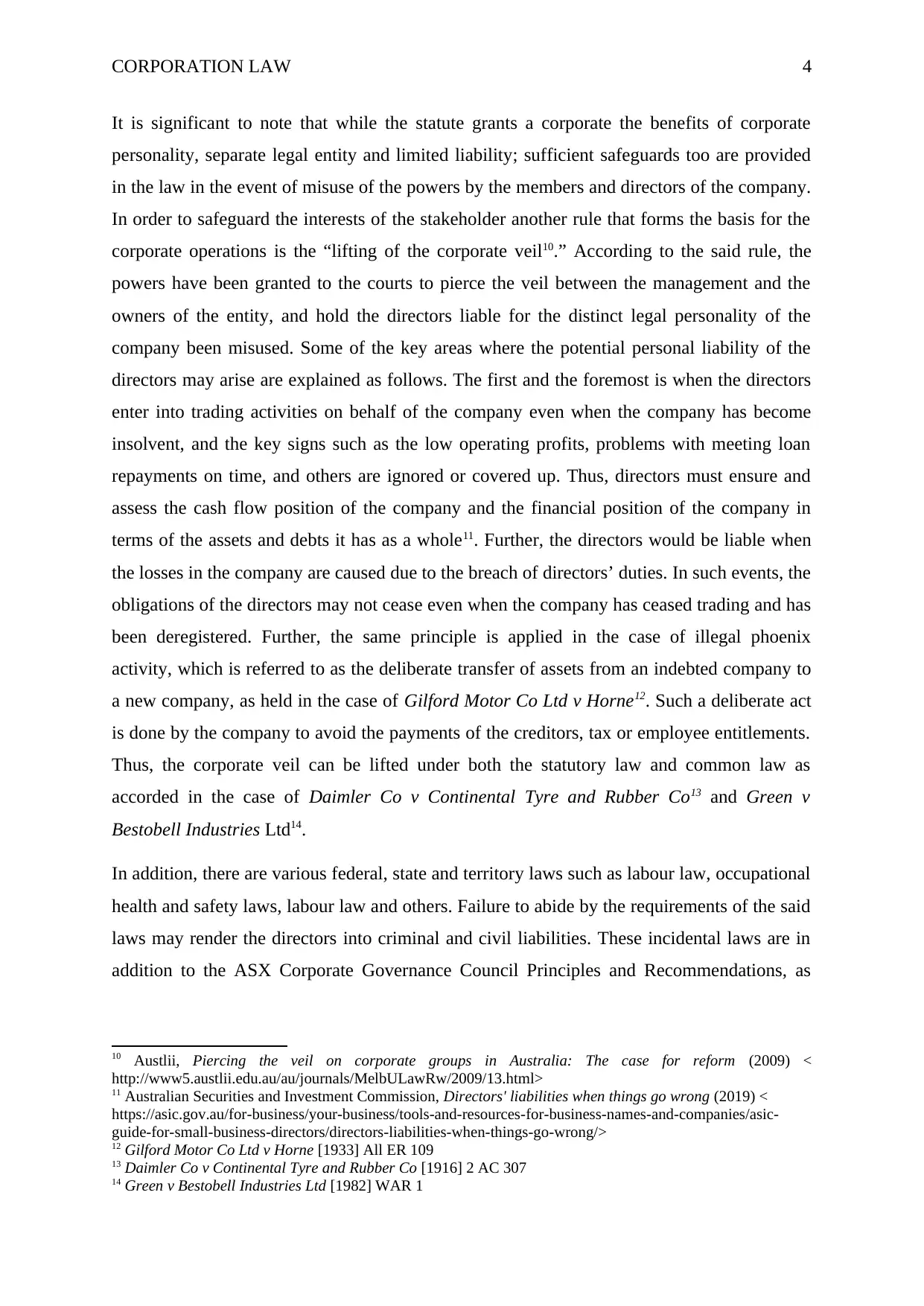
CORPORATION LAW 4
It is significant to note that while the statute grants a corporate the benefits of corporate
personality, separate legal entity and limited liability; sufficient safeguards too are provided
in the law in the event of misuse of the powers by the members and directors of the company.
In order to safeguard the interests of the stakeholder another rule that forms the basis for the
corporate operations is the “lifting of the corporate veil10.” According to the said rule, the
powers have been granted to the courts to pierce the veil between the management and the
owners of the entity, and hold the directors liable for the distinct legal personality of the
company been misused. Some of the key areas where the potential personal liability of the
directors may arise are explained as follows. The first and the foremost is when the directors
enter into trading activities on behalf of the company even when the company has become
insolvent, and the key signs such as the low operating profits, problems with meeting loan
repayments on time, and others are ignored or covered up. Thus, directors must ensure and
assess the cash flow position of the company and the financial position of the company in
terms of the assets and debts it has as a whole11. Further, the directors would be liable when
the losses in the company are caused due to the breach of directors’ duties. In such events, the
obligations of the directors may not cease even when the company has ceased trading and has
been deregistered. Further, the same principle is applied in the case of illegal phoenix
activity, which is referred to as the deliberate transfer of assets from an indebted company to
a new company, as held in the case of Gilford Motor Co Ltd v Horne12. Such a deliberate act
is done by the company to avoid the payments of the creditors, tax or employee entitlements.
Thus, the corporate veil can be lifted under both the statutory law and common law as
accorded in the case of Daimler Co v Continental Tyre and Rubber Co13 and Green v
Bestobell Industries Ltd14.
In addition, there are various federal, state and territory laws such as labour law, occupational
health and safety laws, labour law and others. Failure to abide by the requirements of the said
laws may render the directors into criminal and civil liabilities. These incidental laws are in
addition to the ASX Corporate Governance Council Principles and Recommendations, as
10 Austlii, Piercing the veil on corporate groups in Australia: The case for reform (2009) <
http://www5.austlii.edu.au/au/journals/MelbULawRw/2009/13.html>
11 Australian Securities and Investment Commission, Directors' liabilities when things go wrong (2019) <
https://asic.gov.au/for-business/your-business/tools-and-resources-for-business-names-and-companies/asic-
guide-for-small-business-directors/directors-liabilities-when-things-go-wrong/>
12 Gilford Motor Co Ltd v Horne [1933] All ER 109
13 Daimler Co v Continental Tyre and Rubber Co [1916] 2 AC 307
14 Green v Bestobell Industries Ltd [1982] WAR 1
It is significant to note that while the statute grants a corporate the benefits of corporate
personality, separate legal entity and limited liability; sufficient safeguards too are provided
in the law in the event of misuse of the powers by the members and directors of the company.
In order to safeguard the interests of the stakeholder another rule that forms the basis for the
corporate operations is the “lifting of the corporate veil10.” According to the said rule, the
powers have been granted to the courts to pierce the veil between the management and the
owners of the entity, and hold the directors liable for the distinct legal personality of the
company been misused. Some of the key areas where the potential personal liability of the
directors may arise are explained as follows. The first and the foremost is when the directors
enter into trading activities on behalf of the company even when the company has become
insolvent, and the key signs such as the low operating profits, problems with meeting loan
repayments on time, and others are ignored or covered up. Thus, directors must ensure and
assess the cash flow position of the company and the financial position of the company in
terms of the assets and debts it has as a whole11. Further, the directors would be liable when
the losses in the company are caused due to the breach of directors’ duties. In such events, the
obligations of the directors may not cease even when the company has ceased trading and has
been deregistered. Further, the same principle is applied in the case of illegal phoenix
activity, which is referred to as the deliberate transfer of assets from an indebted company to
a new company, as held in the case of Gilford Motor Co Ltd v Horne12. Such a deliberate act
is done by the company to avoid the payments of the creditors, tax or employee entitlements.
Thus, the corporate veil can be lifted under both the statutory law and common law as
accorded in the case of Daimler Co v Continental Tyre and Rubber Co13 and Green v
Bestobell Industries Ltd14.
In addition, there are various federal, state and territory laws such as labour law, occupational
health and safety laws, labour law and others. Failure to abide by the requirements of the said
laws may render the directors into criminal and civil liabilities. These incidental laws are in
addition to the ASX Corporate Governance Council Principles and Recommendations, as
10 Austlii, Piercing the veil on corporate groups in Australia: The case for reform (2009) <
http://www5.austlii.edu.au/au/journals/MelbULawRw/2009/13.html>
11 Australian Securities and Investment Commission, Directors' liabilities when things go wrong (2019) <
https://asic.gov.au/for-business/your-business/tools-and-resources-for-business-names-and-companies/asic-
guide-for-small-business-directors/directors-liabilities-when-things-go-wrong/>
12 Gilford Motor Co Ltd v Horne [1933] All ER 109
13 Daimler Co v Continental Tyre and Rubber Co [1916] 2 AC 307
14 Green v Bestobell Industries Ltd [1982] WAR 1
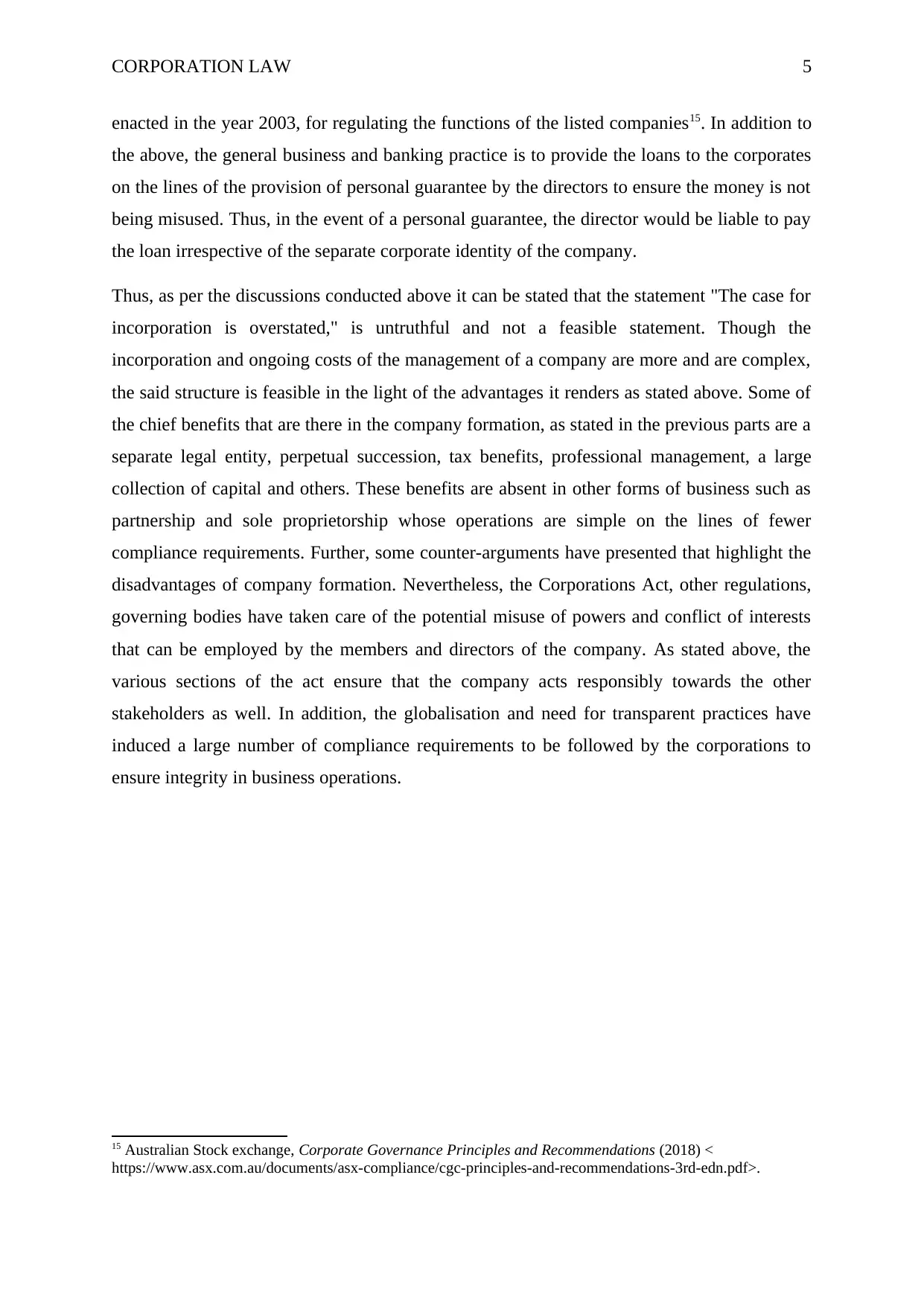
CORPORATION LAW 5
enacted in the year 2003, for regulating the functions of the listed companies15. In addition to
the above, the general business and banking practice is to provide the loans to the corporates
on the lines of the provision of personal guarantee by the directors to ensure the money is not
being misused. Thus, in the event of a personal guarantee, the director would be liable to pay
the loan irrespective of the separate corporate identity of the company.
Thus, as per the discussions conducted above it can be stated that the statement "The case for
incorporation is overstated," is untruthful and not a feasible statement. Though the
incorporation and ongoing costs of the management of a company are more and are complex,
the said structure is feasible in the light of the advantages it renders as stated above. Some of
the chief benefits that are there in the company formation, as stated in the previous parts are a
separate legal entity, perpetual succession, tax benefits, professional management, a large
collection of capital and others. These benefits are absent in other forms of business such as
partnership and sole proprietorship whose operations are simple on the lines of fewer
compliance requirements. Further, some counter-arguments have presented that highlight the
disadvantages of company formation. Nevertheless, the Corporations Act, other regulations,
governing bodies have taken care of the potential misuse of powers and conflict of interests
that can be employed by the members and directors of the company. As stated above, the
various sections of the act ensure that the company acts responsibly towards the other
stakeholders as well. In addition, the globalisation and need for transparent practices have
induced a large number of compliance requirements to be followed by the corporations to
ensure integrity in business operations.
15 Australian Stock exchange, Corporate Governance Principles and Recommendations (2018) <
https://www.asx.com.au/documents/asx-compliance/cgc-principles-and-recommendations-3rd-edn.pdf>.
enacted in the year 2003, for regulating the functions of the listed companies15. In addition to
the above, the general business and banking practice is to provide the loans to the corporates
on the lines of the provision of personal guarantee by the directors to ensure the money is not
being misused. Thus, in the event of a personal guarantee, the director would be liable to pay
the loan irrespective of the separate corporate identity of the company.
Thus, as per the discussions conducted above it can be stated that the statement "The case for
incorporation is overstated," is untruthful and not a feasible statement. Though the
incorporation and ongoing costs of the management of a company are more and are complex,
the said structure is feasible in the light of the advantages it renders as stated above. Some of
the chief benefits that are there in the company formation, as stated in the previous parts are a
separate legal entity, perpetual succession, tax benefits, professional management, a large
collection of capital and others. These benefits are absent in other forms of business such as
partnership and sole proprietorship whose operations are simple on the lines of fewer
compliance requirements. Further, some counter-arguments have presented that highlight the
disadvantages of company formation. Nevertheless, the Corporations Act, other regulations,
governing bodies have taken care of the potential misuse of powers and conflict of interests
that can be employed by the members and directors of the company. As stated above, the
various sections of the act ensure that the company acts responsibly towards the other
stakeholders as well. In addition, the globalisation and need for transparent practices have
induced a large number of compliance requirements to be followed by the corporations to
ensure integrity in business operations.
15 Australian Stock exchange, Corporate Governance Principles and Recommendations (2018) <
https://www.asx.com.au/documents/asx-compliance/cgc-principles-and-recommendations-3rd-edn.pdf>.
⊘ This is a preview!⊘
Do you want full access?
Subscribe today to unlock all pages.

Trusted by 1+ million students worldwide
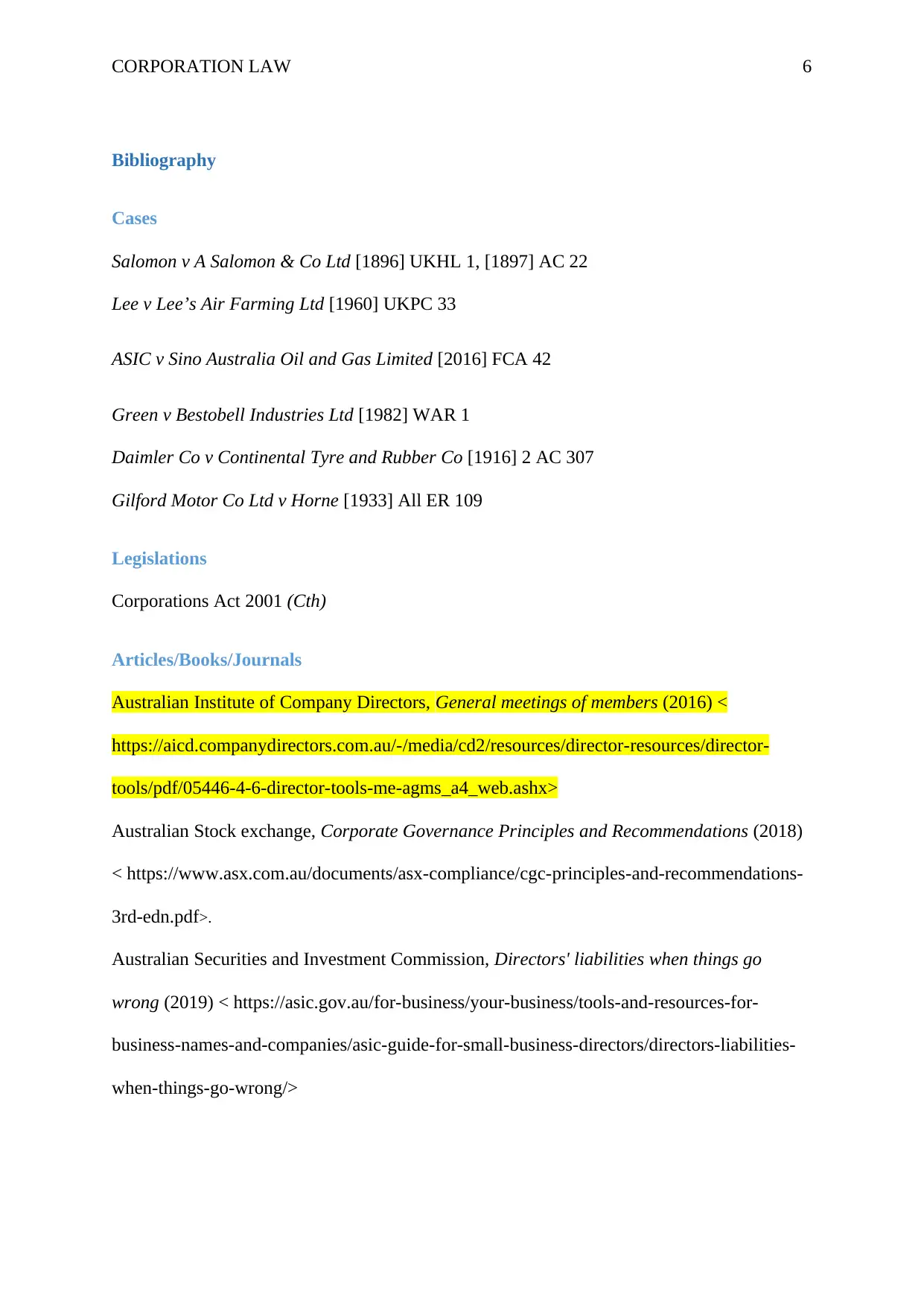
CORPORATION LAW 6
Bibliography
Cases
Salomon v A Salomon & Co Ltd [1896] UKHL 1, [1897] AC 22
Lee v Lee’s Air Farming Ltd [1960] UKPC 33
ASIC v Sino Australia Oil and Gas Limited [2016] FCA 42
Green v Bestobell Industries Ltd [1982] WAR 1
Daimler Co v Continental Tyre and Rubber Co [1916] 2 AC 307
Gilford Motor Co Ltd v Horne [1933] All ER 109
Legislations
Corporations Act 2001 (Cth)
Articles/Books/Journals
Australian Institute of Company Directors, General meetings of members (2016) <
https://aicd.companydirectors.com.au/-/media/cd2/resources/director-resources/director-
tools/pdf/05446-4-6-director-tools-me-agms_a4_web.ashx>
Australian Stock exchange, Corporate Governance Principles and Recommendations (2018)
< https://www.asx.com.au/documents/asx-compliance/cgc-principles-and-recommendations-
3rd-edn.pdf>.
Australian Securities and Investment Commission, Directors' liabilities when things go
wrong (2019) < https://asic.gov.au/for-business/your-business/tools-and-resources-for-
business-names-and-companies/asic-guide-for-small-business-directors/directors-liabilities-
when-things-go-wrong/>
Bibliography
Cases
Salomon v A Salomon & Co Ltd [1896] UKHL 1, [1897] AC 22
Lee v Lee’s Air Farming Ltd [1960] UKPC 33
ASIC v Sino Australia Oil and Gas Limited [2016] FCA 42
Green v Bestobell Industries Ltd [1982] WAR 1
Daimler Co v Continental Tyre and Rubber Co [1916] 2 AC 307
Gilford Motor Co Ltd v Horne [1933] All ER 109
Legislations
Corporations Act 2001 (Cth)
Articles/Books/Journals
Australian Institute of Company Directors, General meetings of members (2016) <
https://aicd.companydirectors.com.au/-/media/cd2/resources/director-resources/director-
tools/pdf/05446-4-6-director-tools-me-agms_a4_web.ashx>
Australian Stock exchange, Corporate Governance Principles and Recommendations (2018)
< https://www.asx.com.au/documents/asx-compliance/cgc-principles-and-recommendations-
3rd-edn.pdf>.
Australian Securities and Investment Commission, Directors' liabilities when things go
wrong (2019) < https://asic.gov.au/for-business/your-business/tools-and-resources-for-
business-names-and-companies/asic-guide-for-small-business-directors/directors-liabilities-
when-things-go-wrong/>
Paraphrase This Document
Need a fresh take? Get an instant paraphrase of this document with our AI Paraphraser
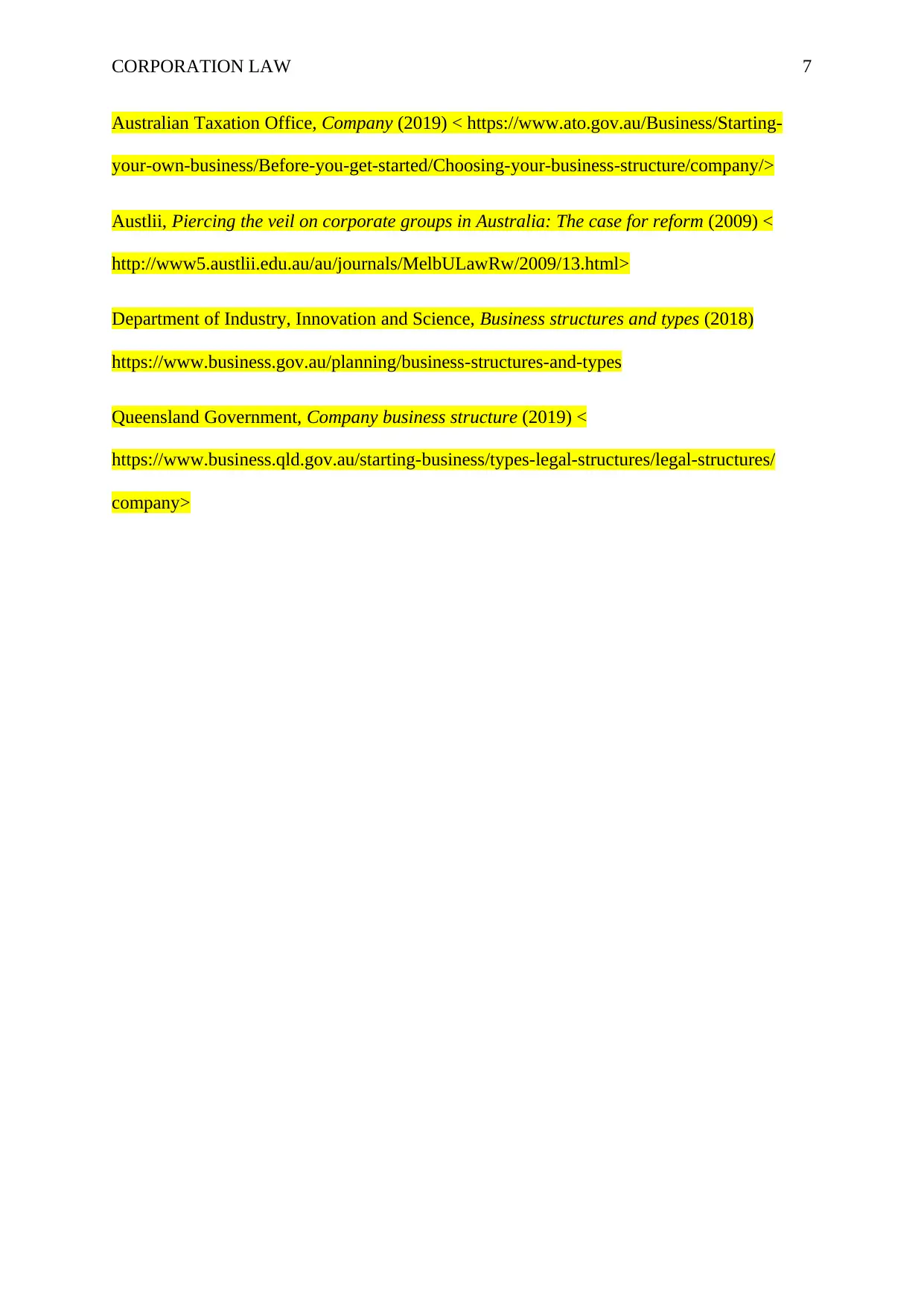
CORPORATION LAW 7
Australian Taxation Office, Company (2019) < https://www.ato.gov.au/Business/Starting-
your-own-business/Before-you-get-started/Choosing-your-business-structure/company/>
Austlii, Piercing the veil on corporate groups in Australia: The case for reform (2009) <
http://www5.austlii.edu.au/au/journals/MelbULawRw/2009/13.html>
Department of Industry, Innovation and Science, Business structures and types (2018)
https://www.business.gov.au/planning/business-structures-and-types
Queensland Government, Company business structure (2019) <
https://www.business.qld.gov.au/starting-business/types-legal-structures/legal-structures/
company>
Australian Taxation Office, Company (2019) < https://www.ato.gov.au/Business/Starting-
your-own-business/Before-you-get-started/Choosing-your-business-structure/company/>
Austlii, Piercing the veil on corporate groups in Australia: The case for reform (2009) <
http://www5.austlii.edu.au/au/journals/MelbULawRw/2009/13.html>
Department of Industry, Innovation and Science, Business structures and types (2018)
https://www.business.gov.au/planning/business-structures-and-types
Queensland Government, Company business structure (2019) <
https://www.business.qld.gov.au/starting-business/types-legal-structures/legal-structures/
company>
1 out of 8
Related Documents
Your All-in-One AI-Powered Toolkit for Academic Success.
+13062052269
info@desklib.com
Available 24*7 on WhatsApp / Email
![[object Object]](/_next/static/media/star-bottom.7253800d.svg)
Unlock your academic potential
Copyright © 2020–2025 A2Z Services. All Rights Reserved. Developed and managed by ZUCOL.





